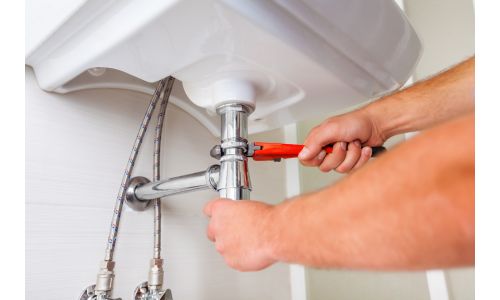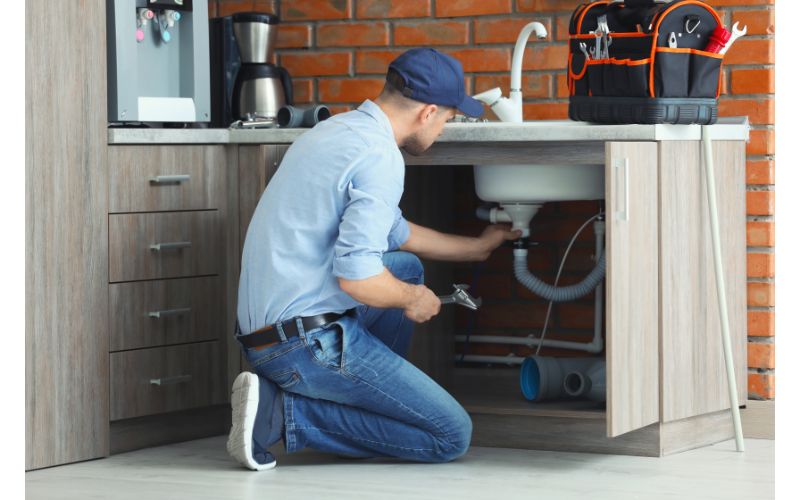Maintaining a leak-free and effective plumbing system in your kitchen or bathroom requires properly sealing a sink drain pipe. To install a new sink or fix the old one, you must understand the sealing process of a sink’s drain pipe.
So how to seal a sink drain pipe? Clear out debris. Place the plumber’s putty around the drain flange before inserting the drain assembly and tightening the drain nut. Connect the drain pipe, use the plumber’s tape, and tighten the fittings. Finally, inspect for drips or leaks around the connections.
In this article, we will lead you through the process of sealing a sink drain pipe and provide step-by-step directions. Explore more about the causes and ways to prevent drain pipe leakage.
Easy Ways to Fix A Sink Drain Pipe
A tight seal keeps sewage gasses and foul odors out of the living area, keeping it sanitary and tidy. You can preserve the durability of your plumbing system while preventing expensive repairs by properly sealing a sink drain pipe.
To seal drain pipes you need an adjustable wrench, plumber’s tape, and putty or silicone caulk. Before starting the process ensure the sink is clean, dry, and debris-free.

Let’s fix the sink drain pipe:
Step 1: Use Silicone Caulk or Plumbers Putty As Sealant
Roll a little silicone caulk or plumber’s putty between your palms to resemble a rope. The metal ring on top of the drain aperture is the drain flange. Press this putty or caulk around the drain flange.
Step 2: Install The Drain Assembly
The drain assembly must rest flat and level with the sink top as you insert it into the drain aperture. Press down on the putty or caulk to compress it and form a watertight seal.
Step 3: Put The Drain Assembly in Place
Find the drain nut or lock nut that holds the drain assembly underneath the sink. Utilizing an adjustable wrench, tighten this nut until it is snug. Be careful not to overtighten, which might harm the sink or drain assembly.
Step 4: Apply Plumber’s Tape
If the threaded fittings on your drain pipe connections are present, wrap some pieces of plumber’s tape around them clockwise. This tape aids in forming a tight seal and stops leaks.
Step 5: Set up The Drain Pipe
Assemble the drain assembly and the drain pipe, making sure they fit snugly. If required, tighten any slip nuts or compression fittings with an adjustable wrench.
Step 6: Examine for Leaks
Turn on the water and let it flow through the sink once everything is connected. Around the connectors for the drain pipe, look for any indications of leaks or drips. If there are any leaks, tighten the fittings even more or think about adding more sealing material.
Potential Causes Behind Sink Drain Pipe Leakage
In this section, we will write about some common causes behind sink drain pipe leakage. You can take preventative actions and solve any concerns by recognizing these typical causes of sink rain pipe leaking.
- Faulty or Lose Connections
Loose or incorrectly placed connections are one of the significant reasons for sink drain pipe leaks. Over time, leaks may develop if the connections between the different parts of the drain pipe are not properly tightened.
- Damaged And Old Seal
The seals that are used to form a watertight barrier in the drain pipe may fail over time. This can happen due to aging, normal wear, and tear, or exposure to harsh chemicals. It may cause leaks around the drain flange or sealed pipe joints.
- Broken Pipe
Inadequate pressure, corrosion, or physical force can cause cracks or damage in PVC or metal pipes. These flaws might allow water to flow through the sink drain line and create leaks.
- Clogs And Obstructions
Leaks may result from persistent obstructions and blockages in the drain line, which increase pressure. Debris, grease, or foreign objects accumulated over time can reduce water flow. This can also increase stress on the pipe, sometimes leading to leaks in weak areas.
- Strong Water Pressure
Leaks can occur due to excessive water pressure on the pipe connections. The seals and fittings may become less durable if the water pressure is constantly too high.
How Do I Stop My Sink Pipe from Leaking?
Here is a list of issues to look for to prevent leakage in the sink pipe:
- Securely fasten all connections, including the drain assembly, compression fittings, and slide nuts.
- Replace any worn-out or broken seals around the drain flange or pipe joints.
- Repair any fractures or damage to the pipes using the proper techniques, or replace the entire damaged portion.
- Clear the pipe of any dirt, grease, or foreign items that might be blocking the pipe or clogging it.
- Verify that the drain pipe has the correct slope to allow water to flow freely. If required, adjust the pipe’s angle to stop water buildup and leaks.
- Install a pressure regulator if your water pressure is constantly high. It will lessen the strain on the pipe connections and lower the possibility of leaks.
- For the pipe connections to function effectively, make sure the sink and countertop are placed correctly and are firmly attached.
Frequently Asked Questions For Seal a Sink Drain Pipe
In this part, we will respond to some readers’ commonly asked queries about repairing sink drain pipes.
Q: What Is The Best Sealant for Sink Drain?
Plumber’s putty or silicone caulk is often the best sealant for sink drains. Plumber’s putty is a flexible, soft substance that molds easily and forms a watertight seal around the drain flange. Another good alternative is silicone caulk, which offers a strong and flexible seal.
Q: Can I Tape A Leaking Pipe to Seal?
Yes, pipe leak tape works to stop leaks. It can cling for years since the adhesive is powerful. Pipe leak tape may be used long-term.
Q: Can Silicone Stop A Pipe Leak?
Yes, a pipe leak can indeed be stopped with silicone. To make a solid and watertight seal, plumbers frequently employ silicone sealants. Silicone creates a flexible and durable barrier that may successfully halt pipe leaks.
Conclusion
Keeping a leak-free and effective plumbing system depends on correctly sealing a sink drain pipe. As described above, this process includes applying the plumber’s putty or silicone caulk, tightening connections, and checking for leaks. Now you know how to seal a sink drain pipe.
You can create a watertight seal for your sink drain pipe by following the instructions provided in this article. By performing periodic inspections and promptly addressing any issues, you can avert the damage. It is always best to seek the help of a qualified plumber if you are hesitant about the procedure.

